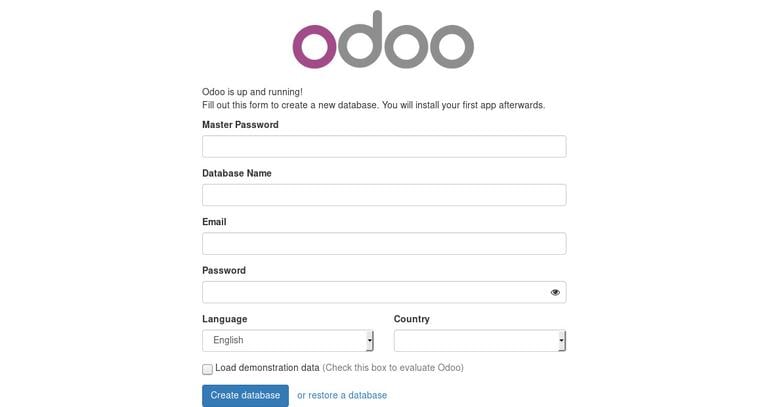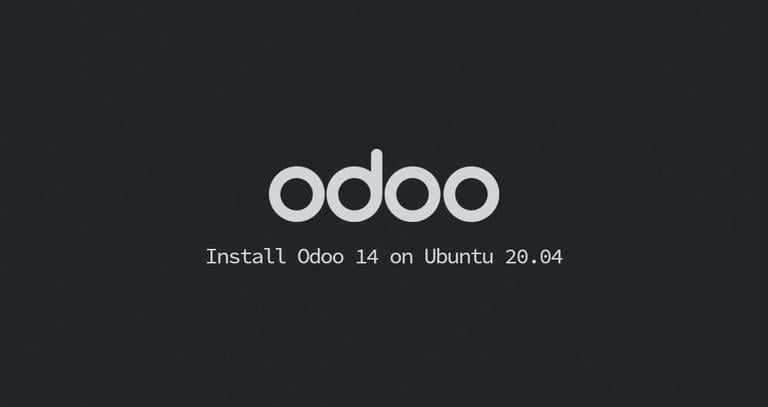How to deploy Odoo 11 on Ubuntu 18.04
Updated on
•10 min read

Odoo is the most popular all-in-one business software in the world. It offers a range of business applications including CRM, website, e-Commerce, billing, accounting, manufacturing, warehouse, project management, inventory and much more, all seamlessly integrated.
There are several ways to install Odoo depending on the required use case. The easiest and quickest way to install Odoo is by using their official APT repositories.
If you want to have more flexibility such as running multiple Odoo versions on a same system then you can either use docker and docker compose or install Odoo in a virtual environment.
This guide covers the steps necessary for installing and configuring Odoo for production using Git source and Python virtual environment on an Ubuntu 18.04 system.
Before you begin
Log in to you Ubuntu machine as a sudo user and update the system to the latest packages:
sudo apt update && sudo apt upgradeInstall Git , Pip , Node.js and the tools required to build Odoo dependencies:
sudo apt install git python3-pip build-essential wget python3-dev python3-venv python3-wheel libxslt-dev libzip-dev libldap2-dev libsasl2-dev python3-setuptools node-lessCreate Odoo user
Create a new system user and group with home directory /opt/odoo that will run the Odoo service.
sudo useradd -m -d /opt/odoo -U -r -s /bin/bash odooInstall and configure PostgreSQL
Install the PostgreSQL package from the Ubuntu’s default repositories:
sudo apt install postgresqlOnce the installation is completed create a PostgreSQL user with the same name as the previously created system user, in our case odoo:
sudo su - postgres -c "createuser -s odoo"Install Wkhtmltopdf
The wkhtmltox package provides a set of open-source command line tools which can render HTML into PDF and various image formats. In order to print PDF reports, you will need the wkhtmltopdf tool. The recommended version for Odoo is 0.12.1 which is not available in the official Ubuntu 18.04 repositories.
Download the package using the following wget command:
wget https://builds.wkhtmltopdf.org/0.12.1.3/wkhtmltox_0.12.1.3-1~bionic_amd64.debOnce the download is completed install the package by typing:
sudo apt install ./wkhtmltox_0.12.1.3-1~bionic_amd64.debInstall and Configure Odoo
We will install Odoo from the GitHub repository inside an isolated Python virtual environment so we can have more control over versions and updates.
Before starting with the installation process, make sure you switch to odoo user.
sudo su - odooTo confirm that you are logged-in as odoo user you can use the following command:
whoamiNow we can start with the installation process. First clone the odoo from the GitHub repository:
git clone https://www.github.com/odoo/odoo --depth 1 --branch 11.0 /opt/odoo/odoo11- If you want to install a different Odoo version just change the version number after the
--branchswitch. - You can name the directory as you like, for example instead
odoo11you can use the name of your domain.
To create a new virtual environment for the Odoo 11 instance run:
cd /opt/odoopython3 -m venv odoo11-venv
activate the environment with the following command:
source odoo11-venv/bin/activateand install all required Python modules with pip3:
pip3 install wheelpip3 install -r odoo11/requirements.txt
pip3 is a tool for installing and managing Python packages.
If you encounter any compilation errors during the installation, make sure that you installed all of the required dependencies listed in the Before you begin section.
Once the installation is completed deactivate the environment and switch back to your sudo user using the following commands:
deactivateexitIf you plan to install custom modules it is best to install those modules in a separate directory. To create a new directory for our custom modules run:
sudo mkdir /opt/odoo/odoo11-custom-addonssudo chown odoo: /opt/odoo/odoo11-custom-addons
Next, we need to create a configuration file, we can either create a new one from scratch or copy the included configuration file:
sudo cp /opt/odoo/odoo11/debian/odoo.conf /etc/odoo11.confOpen the file and edit it as follows:
[options]
; This is the password that allows database operations:
admin_passwd = my_admin_passwd
db_host = False
db_port = False
db_user = odoo
db_password = False
addons_path = /opt/odoo/odoo11/addons
; If you are using custom modules
; addons_path = /opt/odoo/odoo11/addons,/opt/odoo/odoo11-custom-addons
my_admin_passwd to something more secure and adjust the addons_path if you’re using custom modules.Create a systemd unit file
To run odoo as a service we will create a odoo11.service unit file in the /etc/systemd/system/ directory with the following contents:
[Unit]
Description=Odoo11
Requires=postgresql.service
After=network.target postgresql.service
[Service]
Type=simple
SyslogIdentifier=odoo11
PermissionsStartOnly=true
User=odoo
Group=odoo
ExecStart=/opt/odoo/odoo11-venv/bin/python3 /opt/odoo/odoo11/odoo-bin -c /etc/odoo11.conf
StandardOutput=journal+console
[Install]
WantedBy=multi-user.target
Notify systemd that we created a new unit file and start the Odoo service by executing:
sudo systemctl daemon-reloadsudo systemctl start odoo11
You can check the service status with the following command:
sudo systemctl status odoo11● odoo11.service - Odoo11
Loaded: loaded (/etc/systemd/system/odoo11.service; disabled; vendor preset: enabled)
Active: active (running) since Thu 2018-05-03 21:23:08 UTC; 3s ago
Main PID: 18351 (python3)
Tasks: 4 (limit: 507)
CGroup: /system.slice/odoo11.service
└─18351 /opt/odoo/odoo11-venv/bin/python3 /opt/odoo/odoo11/odoo-bin -c /etc/odoo11.conf
and if there are no errors you can enable the Odoo service to be automatically started at boot time:
sudo systemctl enable odoo11If you want to see the messages logged by the Odoo service you can use the command below:
sudo journalctl -u odoo11Test the Installation
Open your browser and type: http://<your_domain_or_IP_address>:8069
Assuming the installation is successful, a screen similar to the following will appear:

Configure Nginx as a SSL termination proxy
If you want to use Nginx as a SSL termination proxy make sure that you have met the following prerequisites:
- You have a domain name pointing to your public server IP. In this tutorial we will use
example.com. - You have Nginx installed by following these instructions .
- You have a SSL certificate installed for your domain. You can install a free Let’s Encrypt SSL certificate by following these instructions .
The default Odoo web server is serving traffic over HTTP. To make our Odoo deployment more secure we will configure Nginx as a SSL termination proxy which will serve the traffic over HTTPS.
SSL termination proxy is a proxy server which handles the SSL encryption/decryption. This means that our termination proxy (Nginx) will handle and decrypt incoming TLS connections (HTTPS), and it will pass on the unencrypted requests to our internal service (Odoo) so the traffic between Nginx and Odoo will not be encrypted (HTTP).
We need to tell Odoo that we will use a proxy, open the configuration file and add the following line:
proxy_mode = True
Restart the Odoo service for the changes to take effect:
sudo systemctl restart odoo11Using Nginx as a proxy give us several benefits. In this example we will configure SSL Termination, HTTP to HTTPS redirection , WWW to non-WWW redirection, cache the static files and enable GZip compression.
# Odoo servers
upstream odoo {
server 127.0.0.1:8069;
}
upstream odoochat {
server 127.0.0.1:8072;
}
# HTTP -> HTTPS
server {
listen 80;
server_name www.example.com example.com;
include snippets/letsencrypt.conf;
return 301 https://example.com$request_uri;
}
# WWW -> NON WWW
server {
listen 443 ssl http2;
server_name www.example.com;
ssl_certificate /etc/letsencrypt/live/example.com/fullchain.pem;
ssl_certificate_key /etc/letsencrypt/live/example.com/privkey.pem;
ssl_trusted_certificate /etc/letsencrypt/live/example.com/chain.pem;
include snippets/ssl.conf;
include snippets/letsencrypt.conf;
return 301 https://example.com$request_uri;
}
server {
listen 443 ssl http2;
server_name example.com;
proxy_read_timeout 720s;
proxy_connect_timeout 720s;
proxy_send_timeout 720s;
# Proxy headers
proxy_set_header X-Forwarded-Host $host;
proxy_set_header X-Forwarded-For $proxy_add_x_forwarded_for;
proxy_set_header X-Forwarded-Proto $scheme;
proxy_set_header X-Real-IP $remote_addr;
# SSL parameters
ssl_certificate /etc/letsencrypt/live/example.com/fullchain.pem;
ssl_certificate_key /etc/letsencrypt/live/example.com/privkey.pem;
ssl_trusted_certificate /etc/letsencrypt/live/example.com/chain.pem;
include snippets/ssl.conf;
include snippets/letsencrypt.conf;
# log files
access_log /var/log/nginx/odoo.access.log;
error_log /var/log/nginx/odoo.error.log;
# Handle longpoll requests
location /longpolling {
proxy_pass http://odoochat;
}
# Handle / requests
location / {
proxy_redirect off;
proxy_pass http://odoo;
}
# Cache static files
location ~* /web/static/ {
proxy_cache_valid 200 90m;
proxy_buffering on;
expires 864000;
proxy_pass http://odoo;
}
# Gzip
gzip_types text/css text/less text/plain text/xml application/xml application/json application/javascript;
gzip on;
}
Once you are done, restart the Nginx service with:
sudo systemctl restart nginxChange the binding interface
This step is optional, but it is a good security practice. By default, Odoo server listens to port 8069 on all interfaces, so if you want to disable direct access to your Odoo instance you can either block port 8069 for all public interfaces or force Odoo to listen only on the local interface.
In this guide we will force Odoo to listen only on 127.0.0.1, open the Odoo configuration add the following two lines at the end of the file:
xmlrpc_interface = 127.0.0.1
netrpc_interface = 127.0.0.1
Save the configuration file and restart the Odoo server for the changes to take effect:
sudo systemctl restart odooEnable multiprocessing
By default, Odoo is working in multithreading mode. For production deployments, it is recommended to switch to the multiprocessing server as it increases stability, and make better usage of the system resources. In order to enable multiprocessing we need to edit the Odoo configuration and set a non-zero number of worker processes.
The number of workers is calculated based on the number of CPU cores in the system and the available RAM memory.
According to the official Odoo documentation to calculate the workers number and required RAM memory size we will use the following formulas and assumptions:
Worker number calculation
- theoretical maximal number of worker = (system_cpus * 2) + 1
- 1 worker can serve ~= 6 concurrent users
- Cron workers also requires CPU
RAM memory size calculation
- We will consider that 20% of all requests are heavy requests, while 80% are lighter ones. Heavy requests are using around 1 GB of RAM while the lighter ones are using around 150 MB of RAM
- Needed RAM = number_of_workers * ( (light_worker_ratio * light_worker_ram_estimation) + (heavy_worker_ratio * heavy_worker_ram_estimation) )
If you do not know how many CPUs you have on your system you can use the following command:
grep -c ^processor /proc/cpuinfoLet’s say we have a system with 4 CPU cores, 8 GB of RAM memory and 30 concurrent Odoo users.
30 users / 6 = **5**(5 is theoretical number of workers needed )(4 * 2) + 1 = **9**( 9 is the theoretical maximum number of workers)
Based on the calculation above we can use 5 workers + 1 worker for the cron worker which is total of 6 workers.
Calculate the RAM memory consumption based on the number of the workers:
RAM = 6 * ((0.8*150) + (0.2*1024)) ~= 2 GB of RAM
The calculation above show us that our Odoo installation will need around 2GB of RAM.
To switch to multiprocessing mode, open the configuration file and append the following lines:
limit_memory_hard = 2684354560
limit_memory_soft = 2147483648
limit_request = 8192
limit_time_cpu = 600
limit_time_real = 1200
max_cron_threads = 1
workers = 5
Restart the Odoo service for the changes to take effect:
sudo systemctl restart odoo11The rest of the system resources will be used by other services that run on our machine. In this guide we installed Odoo along with PostgreSQL and Nginx on a same server and depending on your setup you may also have other services running on your server.
Conclusion
That’s it! This tutorial walked you through the installation of Odoo 11 on Ubuntu 18.04 in a Python virtual environment using Nginx as a reverse proxy . You also learned how to enable multiprocessing and optimize Odoo for production environment. You may also want to check our tutorial about how to create automatic daily backups of your Odoo databases .
If you have questions, feel free to leave a comment below.


